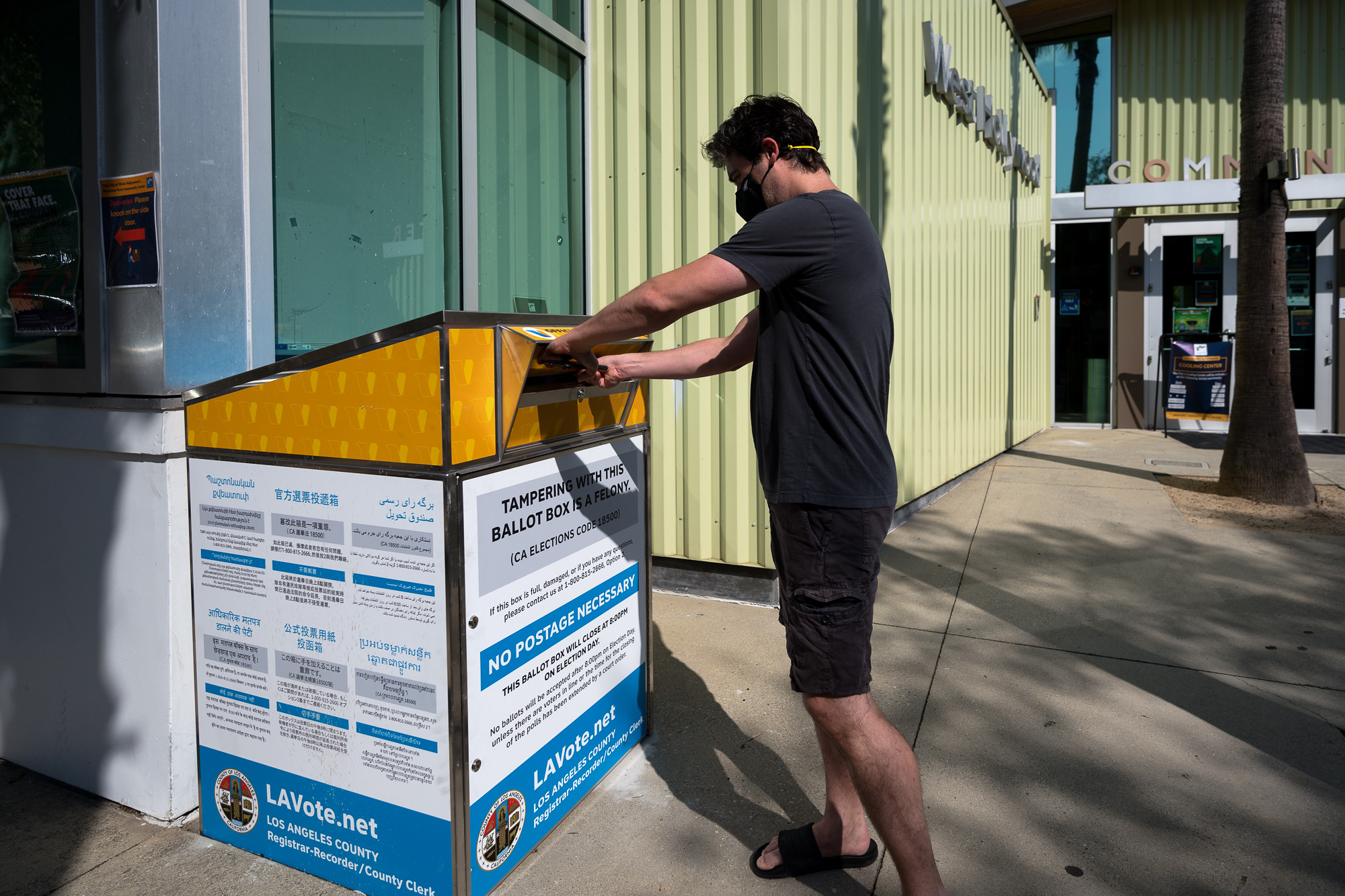Mail Voting Litigation During the Pandemic: Introduction
How have state and federal courts handled mail voting litigation?

Published by The Lawfare Institute
in Cooperation With

This post is the introduction to a five-part series on litigation about mail voting during the 2020 general election. This series is part of Lawfare's collaboration with the Stanford-MIT Healthy Elections Project. Part one of the series explored litigation surrounding application and eligibility to vote by mail. Part two explained current legal battles aimed at removing barriers for submitting mail-in ballots. Part three analyzed legal challenges seeking to expand ballot collection options in the United States. Part four discussed rules governing the verification of mail-in ballots. And part five assessed efforts to halt vote-by-mail expansion in the 2020 general election.
Approximately 80 million Americans are projected to vote by mail in the 2020 general election—double the number who voted by mail in the 2016 election.
To address the surge in demand for mail voting, election officials across the United States have been scrambling to scale vote-by-mail operations and to work with state legislatures and governors to adapt the rules and procedures for mail voting during the coronavirus pandemic. Many state-level initiatives have sought to accommodate the increased demand, and even encourage it, by relaxing rules that create obstacles to mail voting. Other initiatives have sought to slow the growth of vote-by-mail and limit accommodations, citing potential voter fraud. Sometimes those forces have collided within an individual state as parties within the same state have pursued different approaches, leading to heated political debate, deadlock and litigation.
Disputes over the rules of mail voting are playing out in the courts and have also spawned an avalanche of litigation regarding the appropriate ways to adapt, apply and administer the rules for elections during the pandemic. Since March, more than 300 coronavirus-related election cases have been filed in federal and state courts in almost every state, marking what is perhaps the most litigated election season in the past two decades. And most of this litigation relates to the rules associated with mail voting.
To promote public awareness of the stress the pandemic has placed on election and voting laws across the country, a team at the Stanford-MIT Healthy Elections Project has been compiling, summarizing and categorizing this season’s election cases that arise from, or have taken on increased importance in light of, the pandemic. We have published the data in a COVID-Related Election Litigation Tracker. It’s designed to help election officials, legislators, scholars and the interested public find, sort and better understand the recent slew of coronavirus-related election cases. Users can search cases in the tracker by issue, state and party name. Each case includes a short summary, key-issue tags and, where possible, links to key court documents.
But some readers may want a broader run-through of the litigation, without skimping on the important details. So, we summarized this season’s election litigation related to mail voting. We are publishing that summary here, in a five-part series called “Mail Voting Litigation During the Coronavirus Pandemic,” starting with this post. We based the series on cases in the Stanford-MIT COVID-Related Tracker, and more information about individual cases discussed can be found on the tracker. The series outlines the various types of legal challenges to absentee and mail voting practices and procedures brought since March, largely in response to the pandemic. Most of the suits we discuss have been brought against states and counties and their respective officials responsible for the mail voting rules.
Our survey reveals a wide array of legal claims and challenges regarding absentee and mail voting. Most cases seek to expand the availability of, or loosen restrictions associated with, mail voting. But others challenge the expansion of vote-by-mail and defend the associated restrictions, arguing that mail voting leads to fraudulent votes that dilute the weight of genuine votes or that state officials and courts have acted outside of their authority in adopting accommodations. While there is no evidence of widespread fraud in mail voting, there have been isolated instances.
Plaintiffs have challenged every aspect of mail voting, from the application process to state eligibility requirements, from ballot receipt deadlines to voter verification practices. Plaintiffs have alleged a variety of violations—federal and state constitutional violations, federal statutory violations of the Voting Rights Act and the Americans with Disabilities Act, and various state statutory violations.
Claims are at different stages of litigation, and judicial outcomes to date have varied considerably among the states and types of claim. While dozens of cases are still pending and new cases are being filed every week, the Purcell v. Gonzalez doctrine, which discourages courts from issuing rulings that would change voting procedures close to an election date, will become an increasingly important consideration for courts as the election approaches.
This five-part series is organized roughly according to the life cycle of an absentee ballot.
Parts I through IV relate to various efforts to expand mail voting or make it more accessible. Part I covers issues related to the availability of absentee or mail voting. It explores challenges to the processes by which voters apply for and receive absentee ballots, such as cases that seek to require the state to send mail ballot applications or mail ballots to all voters. Part I also examines challenges to eligibility requirements imposed by some states on voters seeking to vote absentee, such as requirements that voters have an “excuse” to vote by mail that is specified in the state’s laws unless they are senior citizens (typically at least 60 or 65 years old).
Part II explores claims related to the rules governing the submission of mail ballots, such as the deadline by which election officials must receive mail ballots. There is a big divide between states that require ballots to be received by Election Day and those that require ballots to be postmarked by Election Day. Part II also explores the “secrecy sleeve” requirement of some states, an issue that garnered attention after a recent Pennsylvania court ruling. The rule rejects any so-called “naked ballots”—ballots that have been returned in the official return envelope but not first placed inside an official “secrecy sleeve” envelope inside the return envelope. Part II also touches on challenges to the requirement to provide postage on a mail-in ballot and claims that mail voting procedures fail to provide accommodations to voters with disabilities.
Part III surveys challenges designed to expand mail ballot drop-off and delivery options. We explore challenges to restrictions on collecting and returning ballots for other voters, sometimes referred to as “ballot harvesting.” We also look at challenges to limits placed by state officials on the number or location of absentee ballot drop-off locations. Finally, Part IV reviews the legal challenges to recent operational changes made by the U.S. Postal Service (USPS) that plaintiffs view as a risk to mail voting. These USPS cases are unique, because they are the only cases seeking to expand or protect mail voting that are not directed at state officials. Rather, they are filed against the federal government and the postmaster general.
Part IV surveys challenges to the most common processes used by election officials to verify that the person who cast the mail ballot is the intended voter. These include signature verification (a practice that entails comparing the signature on a ballot return envelope with an image of the intended voter’s signature on file at the elections office to see if they match) and the requirement that one or more witnesses sign a voter’s mail ballot or return envelope and attest to the voter’s identity. Plaintiffs have also sought to ensure that voters are notified and provided an opportunity to fix or “cure” ballot “defects,” such as a missing signature (when a voter or witness forgets to sign or signs in the wrong place), or a signature that election officials determined does not match the signature on file. Without the ability to cure, election officials do not count ballots with such defects and voters may never know their votes were not counted.
Whereas Parts I through IV focus on legal efforts to expand vote-by-mail and make it more accessible to more voters, Part V focuses on cases that seek the opposite—cases that challenge the expansion of mail voting and the relaxation of the associated restrictions. These cases seek to halt various vote-by-mail accommodations and restrict the use of mail voting. The suits typically challenge policy modifications on one of two grounds: that mail voting increases voter fraud and/or that the officials implementing such policies are not authorized by law to do so. Primarily brought by the Trump campaign and Republican Party operatives, these cases challenge decisions by state officials to send vote-by-mail applications or ballots to all voters in a state, to provide mail ballot drop-off locations that make it more convenient for voters to return their ballots, to loosen voter verification procedures and to extend ballot receipt deadlines during the pandemic.





